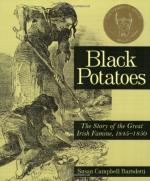|
This section contains 768 words (approx. 2 pages at 400 words per page) |

|
Bartoletti depicts Ireland as a magical and beloved land, which suffered and withstood a calamity. Before the 1840s potato blight, Ireland was a country where people delighted in stories about mythical characters. They praised the lush green island for its beautiful lakes and mountains and fertile fields. The bleak Ireland described during the famine sharply contrasted with this plentiful wonderland. Even a rare snowfall was not received with wonder and joy but as one more obstacle the Irish had to bear.
Barren potato fields are the main setting for the famine. Prior to the blight, the Irish built potato ridges, also called laze-beds, in fields. After the blight caused potatoes to decay into black rotting tubers, these fields became vacant areas where people urgently looked for anything that they could eat.
Ironically, fields planted in grains prospered, but those yields were designated for exports, not indigenous use. The...
|
This section contains 768 words (approx. 2 pages at 400 words per page) |

|




